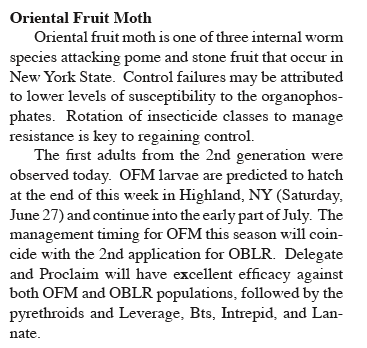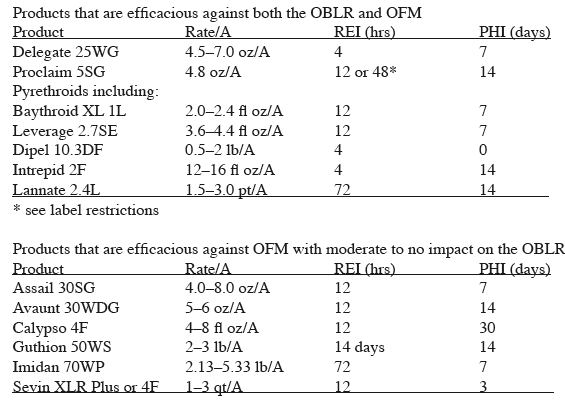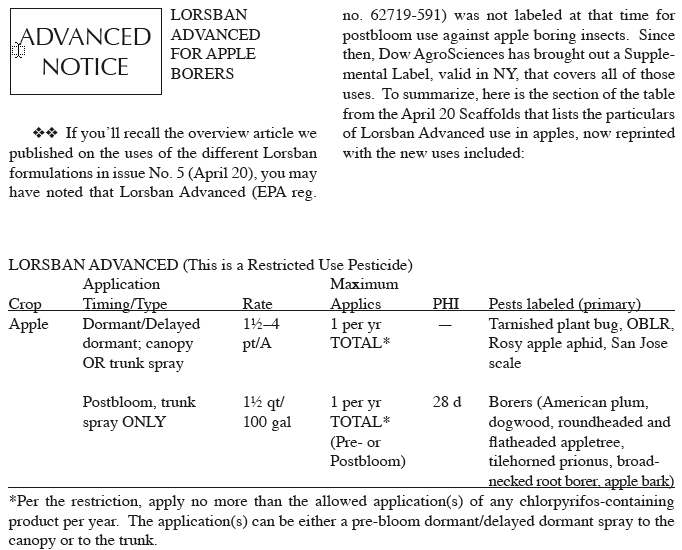Contents
-
Current degree day (DD) accumulations
-
Upcoming meetings
The way I see it
- Scaffolds tid-bits
- Guest Article: Phytophthora root rot
- Going green at Red Apple Farm
- Timely and updated fact sheets available on the UMass Fruit Advisor website
Current (through June 22) degree day (DD) accumulations
Location: UMass Cold Spring Orchard (CSO), Belchertown, MA
Base 43: 1225
Base 50: 728
Significant upcoming orchard events based on degree days (Base 43):
obliquebanded leafroller 1st flight peak: 843–1139
pear psylla 2nd brood hatch: 967–1185
dogwood borer 1st catch: 759–1503
spotted tentiform leafminer 2nd flight starts: 980–1154
apple maggot 1st catch: 1228–1620
Upcoming meetings
July 15, 2009: Massachusetts Fruit Growers' Association Summer Meeting, Tougas Family Farm, Northboro, MA
August 2–5, 2009: International Fruit Tree Association Annual Short Orchard Tour, Nova Scotia, CANADA
December 15-17, 2009: New England Vegetable & Fruit Conference, Manchester, NH
The way I see it
Rain, rain, go away, come back another day. Or not! According to weather data collected at the UMass Cold Spring Orchard in Belchertown and at Tougas Family Farm in Northboro, we have had 5.14 and 4.62 inches of rain respectively in the last 30 days. That's enough. I have noticed a whole new 'class' of large (one inch plus) fruit falling off trees that most likely are the result of thinning sprays and the cloudy weather. Sometimes it is good to see more fruit coming off (Gala) but for some other varieties (McIntosh) it needs to stop now. The Guest Article by David Rosenberger is timely and heeds paying attention. At least the mites are not happy, but that may change when hotter weather arrives.
I hope you plan on attending the Massachusetts Fruit Growers' Association Summer Meeting at Tougas Family Farm on July 15. It should be a great, all-day outdoors program featuring sprayer calibration exercises, sweet cherry hi-tunnels, self-propelled platform, netting options for cherries and blueberries, young bench-grafted apple tree planting, and containerized apple and blueberry nursery. Pre-register for the meeting today!
The next Healthy Fruit will be published on or about July 7.
J. Clements
Scaffolds tid-bits
A few items of interest reprinted from Scaffolds Fruit Journal, June 22, 2009:



Guest Article: Phytophthora root rot
Reprinted from: Tree Fruit Recorded Message for Friday, June 19, 2009
Cornell Cooperative Extension Hudson Valley Regional Fruit Program
Michael J. Fargione, Extension Educator
Dr. David Rosenberger, Cornell Plant Pathologist has discussed with me some of his observations regarding current disease issues. I have attempted to compile his concerns below:
Phytophthora Root Rot
The continuing rains we have experienced may predispose trees to Phytophthora root rot. Here at the HVL, we had 3.8 inches rain from green tip to petal fall (PF) and 2.6 inches of rain from PF to 4 June. We are now approaching 6 inches of rain here since 9 June.
These current conditions remind Dr. Rosenberger of 1982 when a very wet June stimulated a severe outbreak of Phytophthora root rot that killed many young trees and some older ones as well. A study that year showed that drought stress followed by flooding triggered huge releases of Phytophthora zoospores in the soil. This year, we had less droughty prebloom conditions, so the preconditioning for root rot is presumably less than it was in 1982 but still worrisome.
The phosphite fungicides are quickly trans-located from leaves to the root system, and they are very effective for controlling Phytophthora. A simple but cost-effective precaution for preventing root rot would be to include a phosphite fungicide in your next cover spray on apples, pears and stone fruit (within the next 2 weeks). Small trees (up to 3" in diameter?) can be quickly girdled by root rot and are of particular concern (regardless of the variety or rootstock). Apple orchards on MM.106 or M.26 rootstocks, even if the trees are fully mature, should be considered for treatment.
Numerous phosphites are available, but their labels vary widely. Some are not labeled on stone fruit so read labels carefully!. Also, we have no experience applying them to cherries just before harvest. Unless you have already tried it, you may want to wait until immediately after harvest before applying them to bearing cherries.
ProPhyt and Phostrol are two phosphite fungicides that Dr. Rosenberger has tested and found to be effective for controlling sooty blotch and flyspeck on apples. Either product should be combined with captan since they provide no fruit rot control. As we have already entered the period where these diseases are a concern, application of a phosphite plus captan would be a good strategy to start your summer disease control program. You could switch to captan + Topsin-M in your next spray, or continue with the phosphite + captan combination if you are growing for the export market and do not want to use Topsin because of residue concerns.
Going green at Red Apple Farm
Green talk and 15kW turbine ribbon cutting
Wednesday, June 24, 2009, 3:45 to 7:30 PM (panel talks 4 to 5 PM)
Your hosts: the Rose Family, at Red Apple Farm, 455 Highland Ave., Phillipston, MA
Pre-Register today: 508-755-7400 ext. 229
to Monica Elefterion - melefterion@worcester.org
4:00 pm: Panel discussion & Q & A on sustainable and renewable
energy by:
-NEXAMP
-MA Tech Collaborative
-Johnathan Hyde, Green Tourism, Mass. Office of Travel and Tourism
-Gerald Palano, Alternative Energy Specialist, MA Dept of Agriculture
6:15 p.m.: Ribbon Cutting on 15kW Wind Turbine
Followed by:
FREE "Business After Hours" reception hosted by
Enjoy a local "Taste of Local Tourism": complimentary tastes
and drinks from local vendors with a green commitment!
Timely and updated fact sheets available on the UMass Fruit Advisor website
F-119R Foliar Calcium Sprays for Apples
Summary recommendation for using foliar calcium sprays to reduce the incidence of cork spot and bitter pit
- Begin 3 weeks after petal fall
- Apply every 2 weeks until harvest
- Use 0.6 to 0.8 lb calcium (2 lb calcium chloride) per 100 gallons dilute until mid-July
- Use 0.8 to 1.0 lb calcium (3 lb calcium chloride) per 100 gallons dilute after mid-July
- If using calcium chloride, add 2/3 oz vinegar per lb calcium chloride, use a surfactant, avoid Solubor or epsom salts, avoid spraying when very hot, and foliar injury may increase if used with Guthion or Captan
- See the fact sheet noted above for more precautions and details
F-131--2007 Enhancing Return Bloom on Apple with Plant Growth Regulators
Summary recommendation for enhancing return bloom with ethephon
- Begin when fruits are 1-1/4 to 1-1/2 inch in diameter
- Use Ethrel at 0.5 pint per 100 gallons dilute spray -- can be combined with cover sprays
- Make 2 to 3 weekly applications depending on variety (1-2 on early maturing cultivars)
- Avoid applying at high temperatures (90 F.) and/or too early as ethephon can cause significant fruit thinning under the right conditions
- See the fact sheet noted above for more precautions and details
